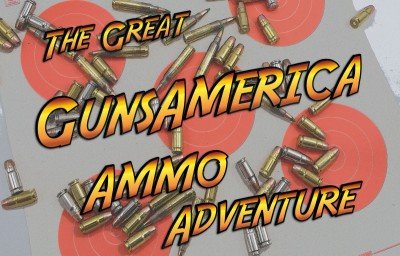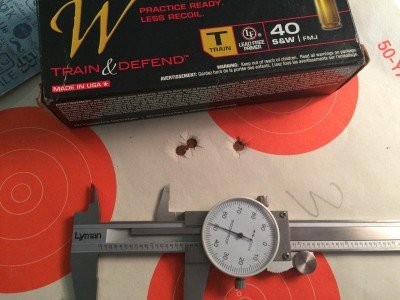
We tested the .40 S&W Winchester Train and Defend in several different guns including this suppressed Glock.
One of the first questions I ask when testing a new product of any kind is “What’s different or unique about this?” In the case of Winchester Train and Defend Ammunition, there are a few “unique” elements to consider.
 It’s simple, especially for newer shooters. For practice, use the boxes marked Train. When you load your gun with self-defense ammo, use the boxes marked Defend. When we live this stuff day in and day out, it’s easy to forget that newer shooters don’t necessarily know the difference between practice and defense ammo. If you use defense ammo to practice, you’ll spend a lot of money. If you use practice ammo for defense, it won’t be nearly as effective.
It’s simple, especially for newer shooters. For practice, use the boxes marked Train. When you load your gun with self-defense ammo, use the boxes marked Defend. When we live this stuff day in and day out, it’s easy to forget that newer shooters don’t necessarily know the difference between practice and defense ammo. If you use defense ammo to practice, you’ll spend a lot of money. If you use practice ammo for defense, it won’t be nearly as effective.
The two variants, Train, and Defend are designed to act and feel similar. The Defend ammo has premium expanding projectiles and low-flash powder, while the Train version does not. However, the weight of the bullets and associated recoil feeling are similar – by design. Your defense ammo will behave in your gun just like the practice stuff you take to the range.
It’s standard pressure ammo, not jacked up +P+Infinity+ stuff. The reason is for controllability. Recoil is less and muzzle flip is minimized, allowing the shooter to make accurate hits and faster follow up shots.
So that’s what’s supposed to be different about Winchester’s Train and Defend, so is it? Let’s take a look a the .40 S&W loading to see.
Function
Like most brand name ammunition, reliable function was a non-issue. I fired it from three different .40 S&W guns, a Beretta PX4, and FNS 40 and a Glock 22. Technically, it was a Glock 31 (.357 Sig) but I swapped out the barrel with a Lone Wolf .40 S&W conversion barrel, essentially making this gun functionally identical to a Glock 22. For you techies, yes, the Lone Wolf has traditional rifling unlike the octagonal rifling in factory Glock barrels, but that won’t make any significant difference in testing here.
As expected, this ammo runs fine, at least in these two guns. Besides, most malfunctions are magazine and gun related anyway, so no big surprise here.
Velocity
I set up my Shooting Chrony Beta Master Chronograph 15 feet downrange and proceeded to clock some rounds. Here’s what I found when I fired both the Train and Defend versions from a Glock 22.
Winchester Train .40 S&W Average velocity: 885.3 feet per second
Winchester Defend .40 S&W Average velocity: 907.7 feet per second
Accuracy
For accuracy, I mounted a Bushnell Elite 3500 Handgun scope on all three handguns. How, you ask? I used the UM Tactical Rail mount, which attaches to the Picatinny rail on a semi-automatic pistol and wraps around the slide. This provides a scope mounting platform up top that does not interfere with the semi-auto cycling of the slide. It’s a really cool solution. The Bushnell Elite 3500 provides up 2x to 6x magnification with plenty of eye relief. This setup allows me to obtain very precise sight pictures at 25 yards, even with my failing eyesight. Yes, I still have to do my part and manage the trigger, but fixing the sight picture takes most of the human error element out of the equation. I used sandbags stabilized by a 25-pound bag of lead shot to provide a solid shooting platform on a sturdy wooden bench.
I fired 5-shot groups and measured best three shots to factor out some of the human error.
Winchester Train, Beretta PX4: 1.8”
Winchester Train, FNS 40: 1.6”
Winchester Defend, Beretta PX4: 2.1”









Leave A Comment